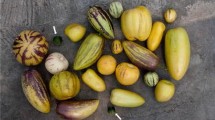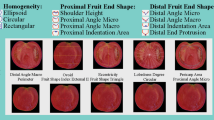Abstract
Conventional tomato (Solanum lycopersicum L.) descriptors are of great utility for gross morphological characterization but may not be practical for the precise fruit description required for distinguishing closely related cultivar groups. Tomato Analyzer is a new phenomics tool that provides multiple fruit morphology data from scanned images of fruit sections. We characterized 69 accessions of local tomato varieties from the region of València (Spain) corresponding to eight cultivar groups (Borseta, Cherry, Cor, Penjar, Plana, Pruna, Redona, and Valenciana) with 64 conventional and 38 Tomato Analyzer descriptors. Significant differences were found among accessions for all traits except for five monomorphic conventional descriptors, revealing a large diversity in the collection. Significant differences were also found among cultivar groups for 36 conventional and 37 Tomato Analyzer descriptors. The groups Borseta, Cherry, Penjar, Plana, and Pruna were clearly distinct and each of them presented many significant differences with the rest of groups. Conventional descriptors did not differentiate well the Cor, Redona, and Valenciana cultivar groups, but Tomato Analyzer descriptors clearly distinguish Valenciana from Cor and Redona groups. A multivariate principal components analysis (PCA) showed that with the exception of six (8.7 %) accessions, the different cultivar groups (including the very similar Cor and Redona) plotted in separate areas of the PCA graph. The results have shown that combined conventional and Tomato Analyzer descriptors in conjunction with PCA analysis are a powerful tool for characterization and classification of local tomato varieties, as well as for distinguishing between related cultivar groups. This has important implications for the enhancement and protection of local tomato varieties.



Similar content being viewed by others
References
Andreakis N, Giordano I, Pentangelo A, Fogliano V, Graziani G, Monti LM, Rao R (2004) DNA fingerprinting and quality traits of Corbarino cherry-like tomato landraces. J Agric Food Chem 52:3366–3371
Blanca J, Cañizares J, Cordero L, Pascual L, Díez MJ, Nuez F (2012) Variation revealed by SNP genotyping and morphology provides insight into the origin of tomato. PLoS One 7:e48198
Bletsos FA, Goulas C (2002) Fresh consumption tomato performance of a local landraces and derived lines. Acta Hortic 579:95–100
Brewer MT, Lang L, Fujimura K, Dujmovic N, Gray S, van der Knaap E (2006) Development of a controlled vocabulary and software application to analyse fruit shape variation in tomato and other plant species. Plant Physiol 141:15–25
Brewer MT, Moyseenko JB, Monforte AJ, van der Knaap E (2007) Morphological variation in tomato: a comprehensive study of quantitative trait loci controlling fruit shape and development. J Exp Bot 58:1339–1349
Brugarolas M, Martínez-Carrasco L, Martínez-Poveda A, Ruiz JJ (2009) A competitive strategy for vegetable products: traditional varieties of tomato in the local market. Spanish J Agric Res 7:294–304
Casals J, Bosch L, Casañas F, Cebolla J, Nuez F (2011) Montgrí, a cultivar within the Montserrat type. HortScience 45:1885–1886
Casals J, Pascual L, Cañizares J, Cebolla-Cornejo J, Casañas F, Nuez F (2012) Genetic basis of long shelf life and variability in Penjar tomato. Genet Resour Crop Evol 59:219–229
Causse M, Friguet C, Coiret C, Lépicier M, Navez B, Lee M, Holthuysen N, Sinesio F, Moneta E, Grandillo S (2010) Consumer preferences for fresh tomato at the European scale: a common segmentation on taste and firmness. J Food Sci 75:S531–S541
Cebolla-Cornejo J, Soler S, Nuez F (2007) Genetic erosion of traditional varieties of vegetable crops in Europe: tomato cultivation in Valencia (Spain) as a case study. Intl J Plant Prod 1:113–127
Cebolla-Cornejo J, Roselló S, Nuez F (2013) Phenotypic and genetic diversity of Spanish tomato landraces. Sci Hortic 162:150–164
Darrigues A, Hall J, van der Knaap E, Francis DM, Dujmovic N, Gray S (2008) Tomato Analyzer-color test: a new tool for efficient digital phenotyping. J Amer Soc Hortic Sci 133:579–586
Díez MJ, Nuez F (2008) Tomato. In: Prohens J, Nuez F (eds) Handbook of plant breeding: vegetables II. Springer, New York, pp 249–323
FAO (2010) The second report on the state of the world’s plant genetic resources for food and agriculture. Food and Agriculture Organization of the United Nations, Rome
García-Martínez S, Corrado G, Ruiz JJ, Rao R (2013) Diversity and structure of a simple of traditional Italian and Spanish tomato accessions. Genet Resour Crop Evol 60:789–798
Gómez R, Costa J, Amo M, Alvarruiz A, Picazo M, Pardo JE (2001) Physicochemical and colorimetric evaluation of local varieties of tomato grown in SE Spain. J Sci Food Agric 81:1101–1105
Gonzalo MJ, van der Knaap E (2008) A comparative analysis into the genetic bases of morphology in tomato varieties exhibiting elongated fruit shape. Theor Appl Genet 116:647–656
Gonzalo MJ, Brewer MT, Anderson C, Sullivan D, Gray S, van der Knaap E (2009) Tomato fruit shape analysis using morphometric and morphology attributes implemented in Tomato Analyzer software program. J Am Soc Hortic Sci 134:77–87
Hammer K (2003) Resolving the challenge posed by agro diversity and plant genetic resources—an attempt. J Agric Rural Dev Trop Subtrop 76:1–184
Hammer K, Diederichsen A (2009) Evolution, status and perspectives for landraces in Europe. In: Vetelainen M, Negri V, Maxted N (eds) European landraces: on-farm conservation, management and use. Bioversity International, Rome, pp 23–43
Hammer K, Knüpffer H, Laghetti G, Perrino P (1999) Seeds from the past: A catalogue of crop germplasm in north-central Italy. Germplasm Institute of C.N.R, Bari
Hammer K, Arrowsmith N, Gladis T (2003) Agrobiodiversity with emphasis on plant genetic resources. Naturwissenschaften 90:241–250
Hurtado M, Vilanova S, Plazas M, Gramazio P, Andújar I, Herraiz FJ, Castro A, Prohens J (2014) Enhancing conservation and use of local vegetable landraces: the Almagro eggplant (Solanum melongena L.) case study. Genet Resour Crop Evol (in press)
IPGRI (1996) Descriptors for tomato (Lycopersicon spp.). International Plant Genetic Resources Institute, Rome
Izzah NK, Lee J, Perumal S, Park JY, Ahn K, Fu D, Kim GB, Nam YW, Yang TJ (2013) Microsatellite-based analysis of genetic diversity in 91 commercial Brassica oleracea L. cultivars belonging to six varietal groups. Genet Resour Crop Evol 60:1967–1986
Lammerts van Bueren ET, Jones SS, Tamm L, Murphy KM, Myers JR, Leifert C, Messmer MM (2011) The need to breed crop varieties suitable for organic farming, using wheat, tomato and broccoli as examples: a review. NJAS Wageningen J Life Sci 58:193–205
Little T, Hills J (1978) Agricultural experimentation: Design and analysis. Wiley, New York
Mazzucato A, Papa R, Bitocchi E, Mosconi P, Nanni L, Negri V, Picarella ME, Siligato F, Soressi GP, Tiranti B, Veronesi F (2008) Genetic diversity, structure and marker-trait associations in a collection of Italian tomato (Solanum lycopersicum L.) landraces. Theor Appl Genet 116:657–669
Mazzucato A, Ficcadenti N, Caioni M, Mosconi P, Piccinini E, Sanampudi VRR, Sestili S, Ferrari V (2010) Genetic diversity and distinctiveness in tomato (Solanum lycopersicum L.) landraces: the Italian case study of ‘a pera Abruzzese’. Sci Hortic 125:55–62
Mohammadi SA, Prasanna BM (2003) Analysis of genetic diversity in crop plants—salient statistical tools and considerations. Crop Sci 43:1235–1248
Panthee DP, Labate JA, McGrath MT, Breksa AP III, Robertson LD (2013) Genotype and environmental interaction for fruit quality traits in vintage tomato varieties. Euphytica 193:169–182
Pitrat M, Hanelt P, Hammer K (2000) Some comments on infraspecific classification of cultivars of melon. Acta Hortic 510:29–36
Rao R, Corrado G, Bianchi M, Di Mauro A (2006) (GATA)4 DNA fingerprinting identifies morphologically characterized ‘San Marzano’ tomato plants. Plant Breed 125:173–176
Rodríguez G, Strecker J, Brewer M, Gonzalo MJ, Anderson C, Lang L, Sullivan D, Wagner E, Strecker B, Drushal R, Dujmovic N, Fujimuro K, Jack A, Njanji I, Thomas J, Gray S, van der Knaap E (2010a) Tomato Analyzer version 3 user manual. http://www.oardc.osu.edu/vanderknaap/files/Tomato_Analyzer_3.0_Manual.pdf
Rodríguez GR, Moyseenko JB, Robbins MD, Morejón NH, Francis DM, van der Knaap E (2010b) Tomato Analyzer: a useful software application to collect accurate and detailed morphological and colorimetric data from two-dimensional objects. J Vis Exp 37:1856
Rodríguez GR, Muñoz S, Anderson C, Sim SC, Michel A, Causse M, Mc Spadden Gardener BB, Francis D, van der Knaap E (2011) Distribution of SUN, OVATE, LC and FAS in the tomato germplasm and the relationship to fruit shape diversity. Plant Physiol 156:275–285
Rodríguez GR, Kim HJ, van der Knaap E (2013) Mapping of two suppressors of OVATE (sov) loci in tomato. Heredity 111:256–264
Rodríguez-Burruezo A, Prohens J, Roselló S, Nuez F (2005) “Heirloom” varieties as sources of variation for the improvement of fruit quality in greenhouse-grown tomatoes. J Hortic Sci Biotechnol 80:453–460
Ruiz JJ, García-Martínez S, Picó B, Gao M, Quiros CF (2005) Genetic variability and relationship of closely related Spanish traditional cultivars of tomato as detected by SRAP and SSR markers. J Am Soc Hortic Sci 130:88–94
Scott JW (2010) Phenotyping of tomato for SolCAP and onward into the void. HortScience 45:1314–1316
Spataro G, Negri V (2013) The European seed legislation on conservation varieties: focus, implementation, present and future impact on landrace on farm conservation. Genet Resour Crop Evol 60:2421–2430
Spooner DM, Hetterscheid WLA, van den Berg RG, Brandenburg WA (2003) Plant nomenclature and taxonomy: an horticultural and agronomic perspective. Hortic Rev 28:1–60
Strecker J, Rodríguez G, Njanji I, Thomas J, Jack A, Darrigues A, Hall J, Dujmovic N, Gray S, van der Knaap E, Francis D (2010) Tomato Analyzer color test manual version 3. http://oardc.osu.edu/vanderknaap/files/Color_Test_3.0_Manual.pdf
Terzopoulos PJ, Bebeli PJ (2008) DNA and morphological diversity of selected Greek tomato (Solanum lycopersicum L.) landraces. Sci Hortic 116:354–361
Terzopoulos PJ, Bebeli PJ (2010) Phenotypic diversity in Greek tomato (Solanum lycopersicum L.) landraces. Sci Hortic 126:138–144
Trichopoulou A, Soukara S, Vasilopoulou E (2007) Traditional foods: a science and society perspective. Trends Food Sci Technol 18:420–427
UPOV (2002) General introduction to the examination of distinctness, uniformity and stability and the development of harmonized descriptors of new varieties of plants (TG/1/3). International Union for the Protection of New Varieties of Plants, Geneva
UPOV (2013) Guidelines for the conduct of tests for distinctness, uniformity and stability: Tomato (TG/44/11 Rev.). International Union for the Protection of New Varieties of Plants, Geneva
Acknowledgments
Authors are grateful to Mrs. Carmen Moreno Piquer for providing the experimental field and cultivation expenses and to Mr. José Soler Sanz for knowledge on diversity and advice on the cultivation of local tomato varieties.
Author information
Authors and Affiliations
Corresponding author
Rights and permissions
About this article
Cite this article
Figàs, M.R., Prohens, J., Raigón, M.D. et al. Characterization of a collection of local varieties of tomato (Solanum lycopersicum L.) using conventional descriptors and the high-throughput phenomics tool Tomato Analyzer. Genet Resour Crop Evol 62, 189–204 (2015). https://doi.org/10.1007/s10722-014-0142-1
Received:
Accepted:
Published:
Issue Date:
DOI: https://doi.org/10.1007/s10722-014-0142-1




